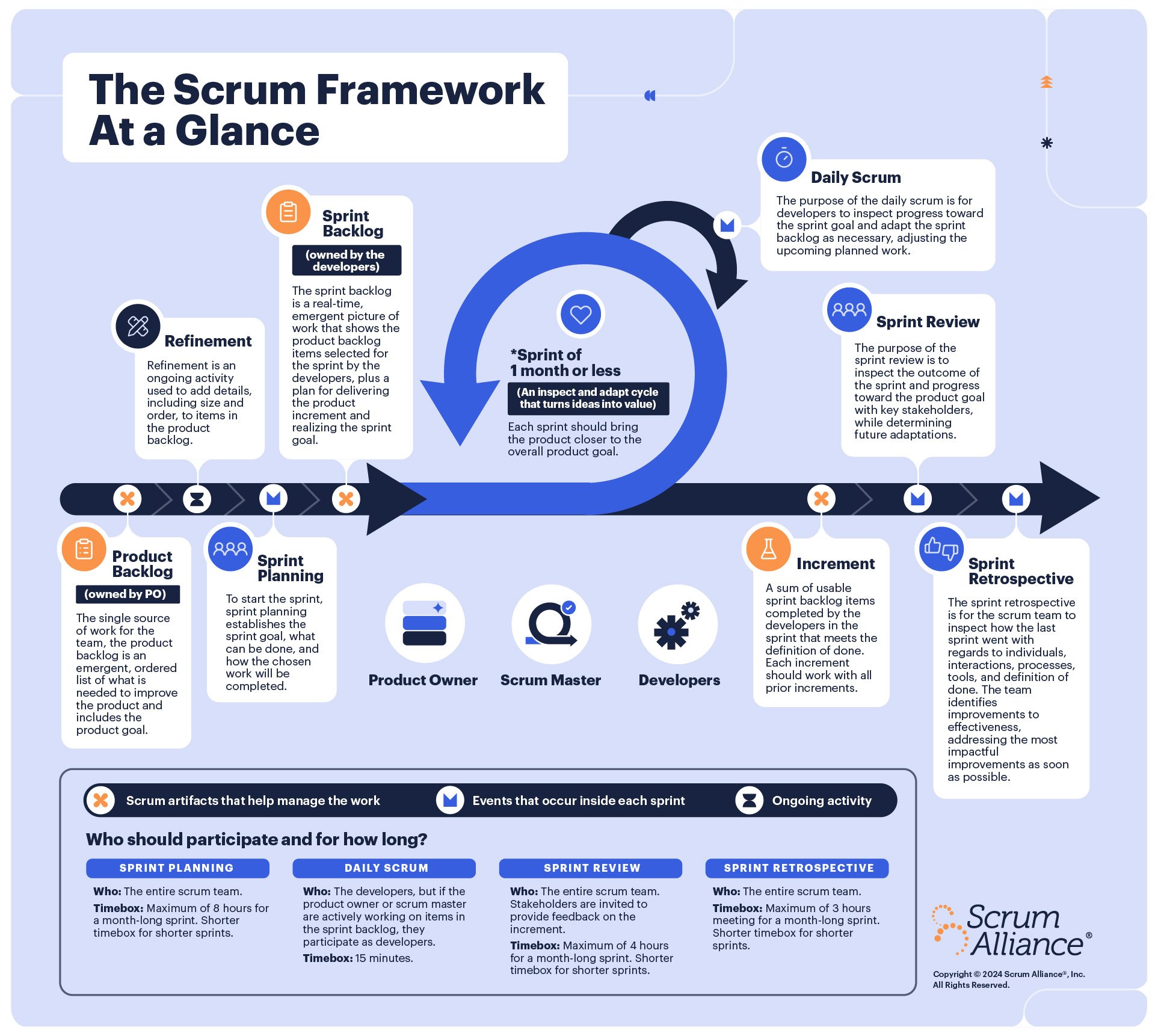Learn about purchasing for teams
What is scrum?
Scrum is a lightweight framework designed to help teams collaborate on complex products iteratively and incrementally to deliver high value. It is built on the principles of empiricism and lean thinking.

About
What is the scrum framework?


Scrum is a lightweight yet incredibly powerful framework. Scrum relies on cross-functional and self-managing teams to deliver products and services in short cycles, enabling:
- Fast feedback
- Quicker innovation
- Continuous improvement
- Rapid adaptation to change
- Delighted customers
- Reduced time from idea to delivery
The term scrum comes from a 1986 Harvard Business Review article (The New New Product Development Game) in which authors Hirotaka Takeuchi and Ikujiro Nonaka made an analogy comparing high-performing, cross-functional teams to the scrummage used by rugby teams. Ken Scwaber and Jeff Sutherland first introduced scrum as a framework at the Object-Oriented Programming, Systems, Languages & Applications (OOPSLA) conference in 1995 in Austin, Texas.
Though it has its roots in software development, today scrum is used in almost every industry so that teams can solve complex problems and deliver innovative products and services that truly delight customers.
The basics of scrum in under 10 minutes
Scrum is the most widely used and popular agile framework. The term "Agile" describes a specific set of foundational principles and values for organizing and managing complex work based on the Agile Manifesto. The creators of the manifesto also considered the words "lightweight" and "adaptive," and eventually all agreed that "agile" was the most effective term for their purposes. The Agile Manifesto was published on February 11, 2001.
Scrum embodies agile principles by enabling teams to adapt quickly to changes (in market requirements, conditions, new regulations, etc.), prioritize customer feedback, and deliver work in manageable increments. Scrum is considered agile because of the agile principles and values it supports:
The Agile Manifesto explains how its creators came to value:
"Individuals and interactions over processes and tools
Working software over comprehensive documentation
Customer collaboration over contract negotiation
Responding to change over following a plan
That is, while there is value in the items on
the right, we value the items on the left more."

Scrum benefits


Practicing scrum offers several advantages, including:
- Minimized risk
- Enhanced ability to manage changing priorities
- Ability to uncover bottlenecks in teams and organizations that get in the way of value delivery
- Increased transparency for stakeholders by delivering working product increments frequently
- Opportunities to inspect and adapt, thereby making course corrections based on what is learned
This framework incorporates inspection and adaptation at regular intervals, helping teams to continuously improve their interactions, reduce time to market, and increase customer satisfaction through regular feedback loops. Moreover, scrum's emphasis on transparency and collaboration fosters a more engaged and motivated team environment, which can lead to higher productivity and better outcomes.
Scrum teams inspect each increment of functionality as it is completed and then adapt what will be done next based on learning and feedback, minimizing risk, and reducing waste. This cycle repeats and continuously gives the stakeholders, business, and the scrum team the opportunity to adjust to changing market conditions, competition, and other reasons for pivoting.
Are you interested in mastering the basics of scrum? Check out Scrum Essentials, an on-demand course exploring the framework's teams, events, and practices. Find out how to leverage scrum to increase customer satisfaction and adaptability to change.

How it works



Scrum's effectiveness lies in its simplicity and flexibility, described later in this page. While it is possible to practice scrum without embodying the scrum values and empiricism (i.e. mechanical scrum), the true benefits of adopting scrum can only be achieved when the scrum team and the organization embody the scrum values and empiricism. Along with organizational and culture shifts catalyzed by adopting those values, the framework has practices based on three core components: Scrum consists of:
- Accountabilities
- Artifacts
- Events
These core components, along with a few simple rules, work together to create a cycle of continuous improvement and adaptation, ensuring that the teams and the organizations can respond swiftly to changes and deliver high-value products effectively.
Scrum accountabilities
Scrum has three accountabilities (previously called "roles") ensuring that every aspect of the shared work is managed effectively.
- Developers: Professionals in the scrum team who work together to create any aspect of the product. They create the product increment(s) during the sprint. People with any skill needed to build the product take on the accountability of a developer. Depending on the nature of the product, the skills will be different.
- Product owner: The product owner develops and communicates the product goal, owns the product backlog, and ensures the team is always addressing the highest value work. They also balance the needs of stakeholders, customers, and the team. They know and understand the domain, the market for their products, and they are passionate about delivering results that customers and users want and need.
- Scrum master: The scrum master leads and guides the organization in its scrum adoption and practice. The scrum master helps the team build the product and become the best team they can be by guiding them to use scrum and embody agile principles. They coach the team toward effective use of the events and artifacts. Their day may include helping the team manage impediments, and they are often essential to the growth of the team as a whole as well as individuals.
There are also many ways scrum masters serve the organization, including coaching the organization and stakeholders in scrum adoption and empiricism.
The scrum team is made up of these accountabilities. A team has one scrum master, one product owner, and the developers. The size of a scrum team is usually fewer than 10 people. The team is self-managing and cross-functional. Many responsibilities of a traditional project manager are divided between the accountabilities while other project management responsibilities may become unnecessary.
Scrum events
There are five events in the scrum framework. These events are valuable opportunities to inspect and adapt the product or the way the team works together (and sometimes both).
- The sprint: The core of scrum, a timeboxed period (less than one month long and frequently 1-2 weeks) during which one or more increments are created. The sprint contains all of the other events.
- Sprint planning: The entire scrum team establishes the sprint goal. The developers forecast what work they believe they can accomplish during the sprint to support the goal, and how the chosen work will be completed. Planning should be timeboxed to a maximum of 8 hours for a month-long sprint, with a shorter timebox for shorter sprints. Based on the sprint goal and the forecast, an initial plan is also created. The scrum team may invite other people to sprint planning to provide advice or input on relevant work.
- Daily scrum: During daily scrum, the developers inspect the progress toward the sprint goal and adapt plans as necessary. It's a brief daily event led by the developers to inspect and adapt. It is timeboxed to 15 minutes. Daily scrum is not the team's only opportunity to adapt their plans; they often communicate about needed pivots outside of this event. In daily scrum, the team may synchronize their daily work, identify blockers, and discuss collaboration that needs to take place. Daily scrum helps the team understand if their latest plans will get them closer to achieving the sprint goal and they pivot if needed.
- Sprint review: The entire scrum team inspects the sprint's outcome with stakeholders and determines future adaptations. Stakeholders are invited to provide feedback on what that scrum team has achieved so far and on the future direction of product development. The product backlog is adapted based on these conversations.
- Sprint retrospective: The conclusion of the sprint, the retrospective is the team's opportunity to inspect their own interactions, collaborations, processes, tools, and any other factors they deem relevant to their ability to continuously improve.
Product backlog refinement
Refinement is a continuous activity used to prepare product backlog items for the upcoming sprint plannings. Teams may adjust details such as description, order, and size. It is not a scrum event. Some teams prefer a recurring meeting, usually done once or twice per sprint. Other teams prefer to refine backlog items as needed.
While the product owner is ultimately accountable for the state and the content of the product backlog, they can delegate product backlog management to others (but cannot delegate the accountability). The buck stops with the product owner.
Scrum artifacts
Scrum artifacts enable transparency, inspection, and adaptation. They provide visibility into the work being completed so that anyone—the team, stakeholders, managers, etc.—can inspect the results and identify areas where an adaptation may benefit the product.
- Product backlog: An ordered or ranked list of everything that might be needed to improve the product, along with the product goal. The product goal is the commitment to the product backlog and is part of the product backlog.
- Sprint backlog: It consists of the sprint goal plus the set of product backlog items the product owner and developers have forecasted they can complete during the current sprint (they may not finish them all), plus a plan for delivering the increment and achieving the sprint goal. The sprint goal is the commitment for the sprint backlog and does not change during the sprint (while the “scope of work” may actually change). As the plan changes (during the sprint or during daily scrum) those changes are reflected on the sprint backlog.
- Increment: When a product backlog Item is completed (as per the quality attributes defined for the product - captured usually in the Definition of Done) in such a way that it delivers value and is usable, it becomes an "Increment." Each increment is additive because it does not break what has been previously completed and will continue to work indefinitely into the future when new PBIs are completed. The commitment to the increment is the definition of done.
Scrum artifact commitments
In the scrum framework, each artifact is accompanied by a specific commitment that ensures the work focuses on delivering quality and value.
- Definition of Done for the increments: The Definition of Done establishes the quality measures for the product that the product backlog items must meet to be considered complete. Once a product backlog item meets the definition of done, it becomes an increment.
- Sprint goal for the sprint backlog: A specific and singular goal for the sprint that clarifies the sprint's purpose. The sprint goal is the commitment to the sprint backlog. This goal helps everyone focus on the essence of what needs to be done and why. The sprint goal must allow the developers to be flexible about the exact "scope" of work that is done. The sprint goal brings cohesion to the work done during the sprint.
- Product goal for the product backlog: A clear understanding of the product's overarching objective is essential for teams to effectively organize the work.The product may have multiple product goals over its lifetime, but only one at a time.
How it all works together
Scrum accountabilities, artifacts, and events work together within the sprint. The product owner defines the direction of product development with a product goal using information from stakeholders and users. They identify and define pieces of value that can be delivered to move closer toward the product goal.
The product owner ensures that the product backlog is ordered so that the team knows what is most important. The developers can help the product owner further refine what needs to be done, and the product owner may rely on the developers to make trade-off decisions. This is where refinement becomes an important practice for the scrum team.
Getting started
While the framework defines the bare essentials, here are some considerations to get started:
- Define the "product" and the "boundary" of the product
- Form new scrum teams
- Define product goal and a few product backlog items
- Create a definition of done
During sprint planning, the scrum team collaborates to create the sprint goal. Based on the sprint goal, the developers pull work (usually from the top) of the product backlog and decide how they will complete it. The team has a set time frame, the sprint, to achieve the sprint goal. They meet at the daily scrum to inspect progress towards the sprint goal and plan for the upcoming day. Along the way, the scrum master keeps the team focused on the sprint goal and can help the team improve as a whole.
Wrapping up the sprint
The scrum team shares its sprint results with stakeholders in sprint review. They may adapt the product backlog as part of that review and in sprint planning.
The team has a sprint retrospective to discuss what went well and what didn't go well during the sprint. They may discuss collaborations, tools, communication, and practices that supported or hindered their ability to achieve their sprint goal. They develop action items based on what they discussed in order to improve future sprints.
In sprint planning, the team chooses the product backlog items for the next sprint and the cycle repeats.
Transitioning to an agile framework such as scrum requires a new mindset and overall cultural adjustments. And, like all change, it doesn't come easy. But when teams and organizations fully commit to scrum, they'll discover a new sense of flexibility, creativity, and inspiration—all of which will lead to greater results.

Scrum values


Commitment
The scrum value of commitment is essential for building an agile culture. Scrum teams work together to support each other in their pursuit of the product goal and sprint goals. This means that scrum teams trust each other to follow through on what they say they are going to do. When team members aren’t sure how work is going, they ask. Scrum teams only agree to take on tasks they believe they can complete, so they are careful not to overcommit.
Courage
The scrum value of courage is critical to a scrum team’s success. Scrum teams must feel safe enough to say no, ask for help, and try new things. Agile teams must be brave enough to question the status quo when it hampers their ability to succeed.
Focus
Every member of the scrum team focuses on the work at hand to support the sprint goal.
Openness
Scrum teams consistently seek out new ideas and opportunities to learn. Scrum teams are also honest when they need help and open with their team and stakeholders about the challenges they face.
Respect
Scrum team members demonstrate respect to one another, to the product owner, to stakeholders, and to the scrum master. Scrum teams know that their strength lies in how well they collaborate and that everyone has a distinct contribution to make toward completing the work of the sprint. They respect each other's ideas, give each other permission to have a bad day once in a while, and recognize each other's accomplishments.

Empiricism and iteration


Scrum operates on core elements that make it exceptionally suited for handling complex, evolving projects. This framework facilitates a balance between structure and adaptability, enabling teams to efficiently tackle changing demands and deliver quality outcomes. Through its elements, scrum provides a lightweight set of enabling constraints for teams to follow as they work through uncertainties and aim for continuous improvement in their work.
The three pillars of empirical process control
Scrum is based on the theory of empirical process control, which relies on transparency, inspection, and adaptation.
Transparency
Effective decision-making requires transparency of the process and of the product's progress and a shared language among participants to ensure everyone understands what they're seeing.
The five scrum events provide appropriate opportunities for transparency, inspection, and adaptation.
Inspection
Regular inspections of ongoing work are essential for maintaining the intended process and achieving the desired outcome. Integrating these inspections seamlessly into the workflow prevents any disruption.
Sprint review and sprint planning offer an opportunity to inspect progress toward the product goal, and retrospectives offer opportunities for the team to inspect their teamwork, collaborations, and processes. This process promotes continuous improvement while ensuring progress continues unhindered.
Adaptation
Adaptation involves making timely adjustments to the process or product whenever deviations arise. Scrum teams have the flexibility to adapt the product backlog, product, and their future plans every sprint. This ensures that any necessary changes can be implemented as rapidly as the balance of demands and capacity allows.
Iterative and incremental product management
Scrum combines iterative and incremental approaches.
Iterative
In an iterative process, teams repeatedly cycle through rounds of delivery to arrive at a desired outcome. Each iteration brings the team closer to its goal, allowing for adjustments based on learning and feedback. This cycle of iterative improvement is a key characteristic of scrum, allowing teams to systematically make progress with each iteration.
Incremental
Incremental refers to a series of small improvements to an existing product or product line that usually helps maintain or improve its competitive position over time. Incremental innovation is regularly used within the high-technology business by companies that need to continue to improve their products to include new features increasingly desired by consumers. The way scrum teams deliver pieces of functionality into small batches is incremental.

Explore scrum certifications


Scrum Alliance certification courses offer in-depth training by leaders in agile and scrum. Choose from courses that focus on a specific scrum team accountability or an agile skill. Foundational role-based courses like the Certified ScrumMaster and all of the skill-based courses have widely applicable training that you can implement right away, no matter your role.


